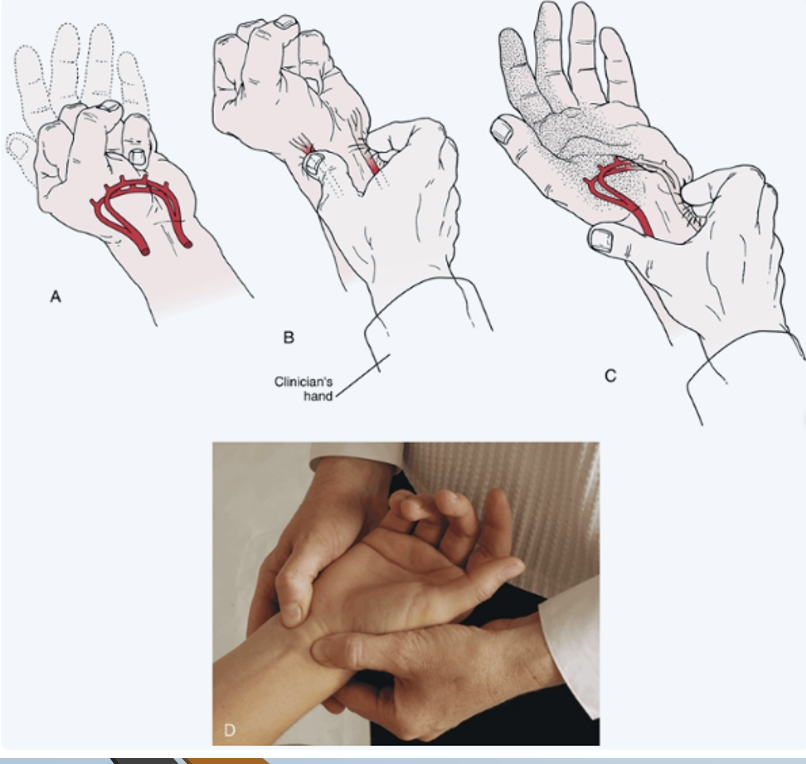Testable SOT term 2
1/88
There's no tags or description
Looks like no tags are added yet.
Name | Mastery | Learn | Test | Matching | Spaced |
|---|
No study sessions yet.
89 Terms
Upper Limb Tests
Anterior Drawer Test
Purpose: tests for anterior GH instability
Positive signs: Hypermobility, clicking, apprehension
Method:
Patient lies supine
Abduct shoulder to 80-120 degrees, flexed forward to 20 degrees, laterally rotated up to 30 degrees
Therapist stabilizes scapula
Draws humerus forward
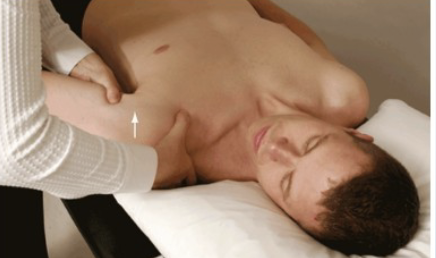
Posterior Drawer
Purpose: Tests for posterior instability
Positive Signs: Hypermobility, pain, apprehension
Method:
Start same position as anterior drawer- supine
Medially rotate arm and flex forward to 60-80°
Apply posterior force
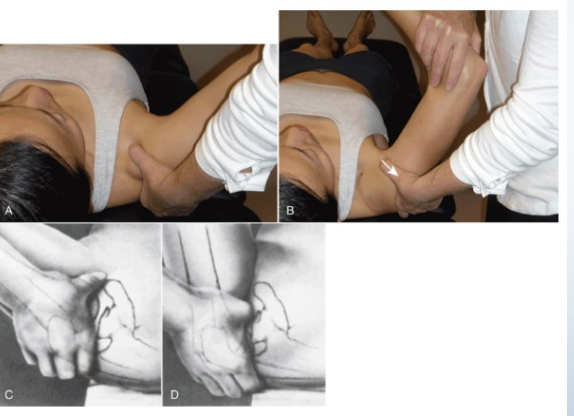
Apprehension/Crank Test
Purpose: Tests for gross instability of GH joint
Positive Signs: Apprehension, muscle spasm
Method:
Patient supine- at edge of table so arm can go off edge
Abduct to 90 degrees and fully externally rotate
Apply overpressure if no pain (push down on their arm)
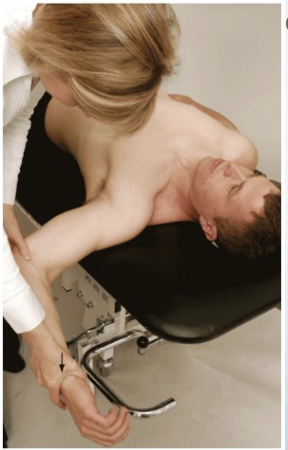
Push Pull Test
Purpose: Tests for posterior instability
Positive Signs: Hypermobility, pain, apprehension
Method:
Patient supine
Abduct arm to 90 degrees, flex to 30 degrees
Downward push at shoulder and upward pull at wrist
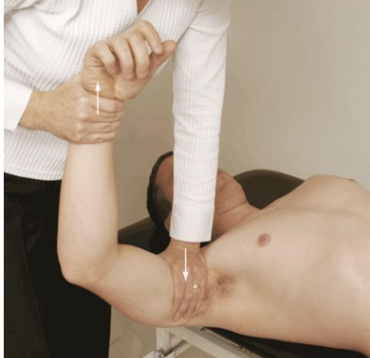
Sulcus Sign
Purpose: Tests for inferior G/H instability
Positive Signs: Hypermobility, sulcus sign, with pain/apprehension
Method:
Arm relaxed at side
Distal pull of humerus
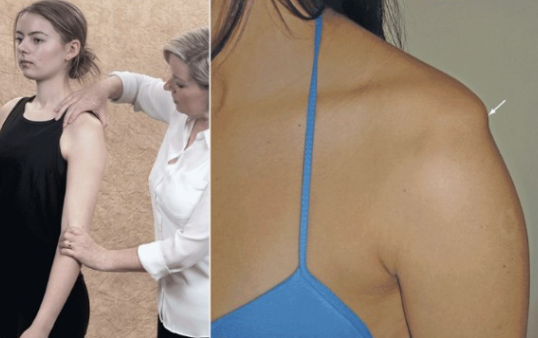
Hawkins-Kennedy Test
Purpose: Tests for supraspinatus tendinopathy/impingement
Positive Signs: Pain, apprehension
Method:
Seated or standing
Forward flex arm to 90 degrees, medially rotate
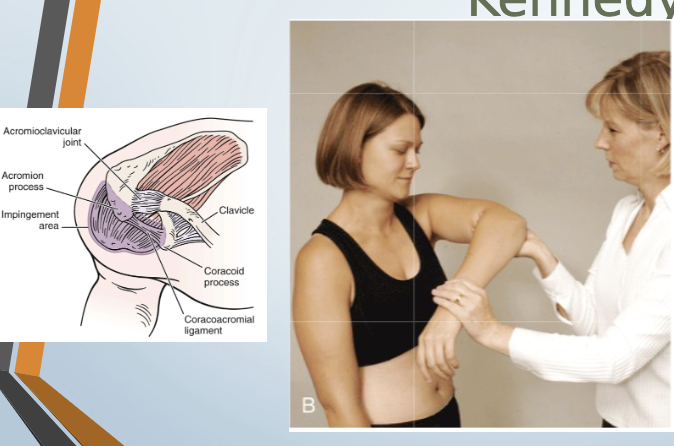
Neer Impingement Test
Purpose: Tests for supraspinatus overuse injury
Positive Signs: Pain, apprehension
Method:
Seated or standing
Abduct arm in scaption, medially rotated

Painful Arc
Purpose: Tests for compression of subacromial structures
Positive Signs: Pain during mid-arc, pain at 170-180° indicates AC injury
Method:
AFROM abduction
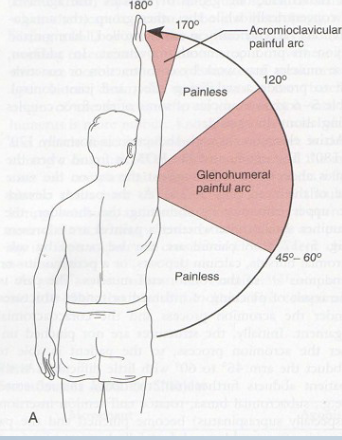
Apley’s Scratch Test
Purpose: Tests combined shoulder movements- internal and external rotation
Positive Signs: Normal fingertip touching range
Method:
Demonstrate to client to mimic
one arm over and behind shoulder
One arm reaching under and up to touch other hand
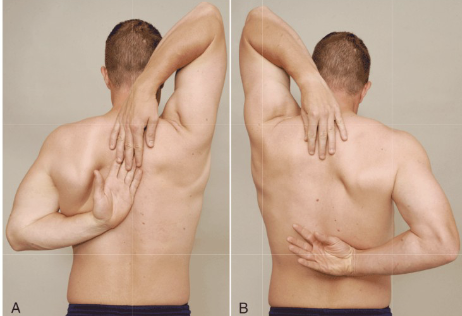
AC Shear Test
Purpose: Tests acromioclavicular joint pathology
Positive Signs: Pain, hypermobility
Method:
Seated
Hands on clavicle and spine of scapula
Interlock fingers one hand on each side of shoulder
Squeeze together
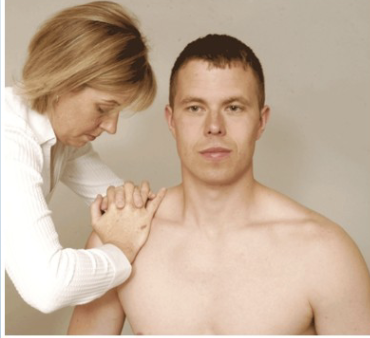
Drop Arm
Purpose: Tests for rotator cuff tear
Positive Signs: Inability to slowly lower arm, pain
Method:
Abduct shoulder to 90 degrees
Client lowers arm slowly to side
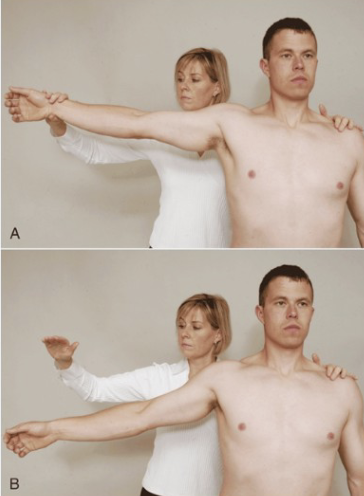
Speed’s Test
Purpose: Tests for bicipital tendinopathy
Positive Signs: Pain in bicipital groove
Method:
Seated
Resists shoulder forward flexion in supination then pronation
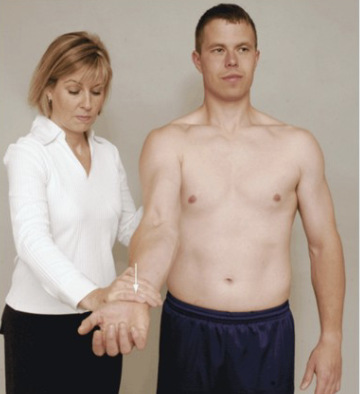
Empty Can/ Jobes
Purpose: Tests for supraspinatus muscle/tendon tear
Positive Signs: Muscle weakness, pain
Method:
Abducted arm to 90 degrees in neutral, resist
Rotate medially into scaption and resist again
Resist at wrists pushing downward
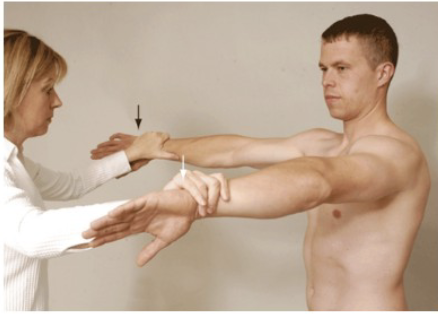
Yergason’s Test
Purpose: Tests for transverse humeral ligament integrity
Positive Signs: Biceps tendon pops out, pain in biccipital groove
Method:
Seated
Palpate biccipital groove
Elbow flexed medially and pronated then
Resist supination and lateral rotation with elbow flexed
Like a hitchhike
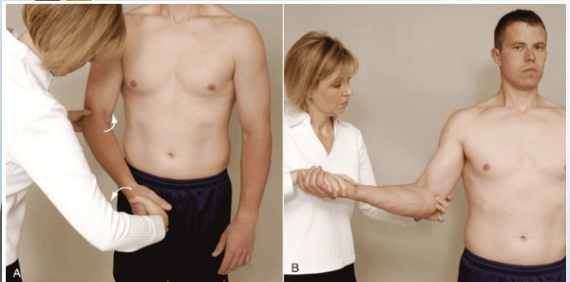
Adson’s Test
Purpose: Tests for anterior scalene-related TOS
Positive Signs: Pain into arm, loss of pulse
Method:
Seated
Palpate radial pulse, rotate head towards test shoulder
Extend head
Therapist externally rotates and extends shoulder
Patient takes deep breath and holds
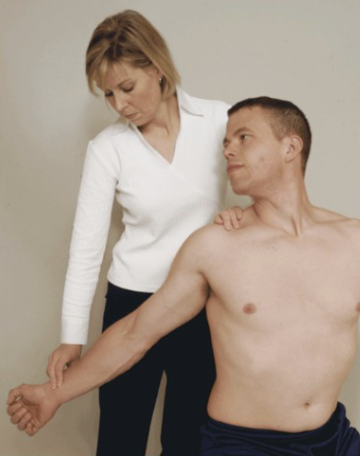
Travell’s Test
Purpose: To assess for compression of the brachial plexus or subclavian artery ( Thoracic Outlet syndrome
Positive Signs: Decrease in radial pulse, Pain into arm
Method:
Client Sits
monitor radial pulse
Rotate and extend head away from test shoulder
Unlike Adsons which is toward affected side
Wright’s Hyperabduction Test
Purpose: Tests for pec minor-related TOS
Wright’s Hyperabduction Test and costoclavicular TOS when hyperabducted
Positive Signs: Increased symptoms, decreased radial pulse
Method:
Seated
Passively fully abduct arm to 180 degrees with slight extension
Monitor the radial pulse
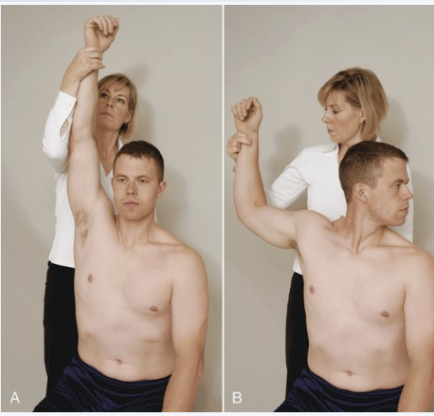
Halstead’s Test
Purpose: Tests for scalene-related TOS
Positive Signs: Pain into arm, neurological symptoms
Method:
Seated
Rotate head AWAY from test shoulder then extend head
Therapist externally rotates and extends shoulder with downward traction
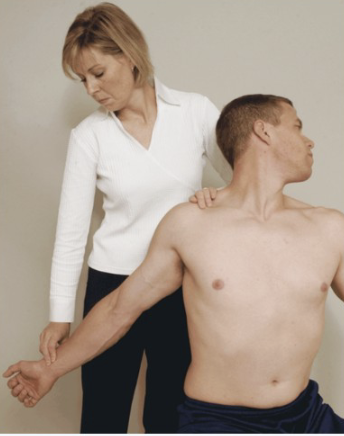
Eden’s Test (Military Brace)
Purpose: Tests for costoclavicular-related TOS
Positive Signs: Increased neurological symptoms, decreased radial pulse
Method:
Monitor radial pulse,
Therapist depress and retract affected arm
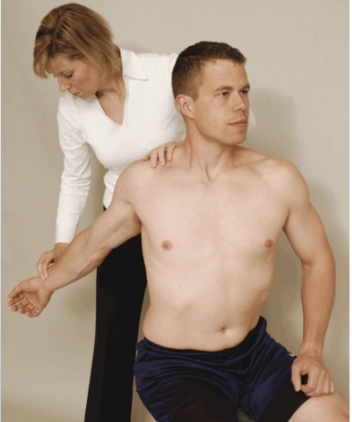
Shoulder Depression Test
Tests for:
• Brachial plexus
compression/irritation
• Multiple cervical nerve root
irritation
• Foraminal encroachment on
compressed side (osteophytes)
• Hypomobile joint capsule on
elongated side
•Positive sign:
• Increased pain and neurological symptoms
•Method:
• Patient seated
• Therapist applies downward
pressure to shoulder while side
flexing head to opposite side
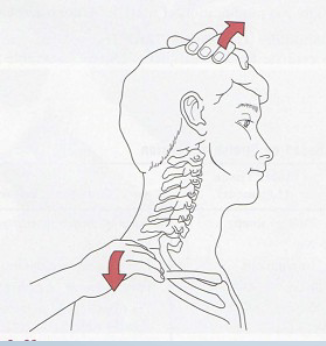
Brakody’s Test/ Shoulder abduction
•Tests for:
• C4, C5, C6 nerve root
compression
• Herniated disc
•Positive sign:
• Decreased pain and
neurological symptoms (also
known as Brakody’s sign)
•Method:
• Patient seated or lying down
• Therapist passively (or
patient actively) elevates
arm through abduction so
that the hand or forearm
rests on top of the head
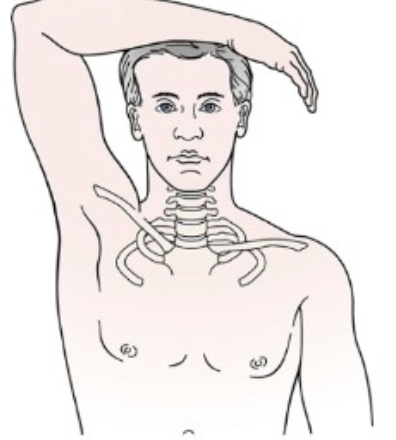
Elbow Tests
Varus/ Valgus
•Tests for:
• Medial (ulnar) and lateral (radial) collateral ligament instability
• Varus stress also can stress the anular ligament of the radius
•Positive sign:
• Hypermobility/Pain
•Method:
• Patients elbow in slight flexion
• A varus (adduction) force is applied by the therapist to the distal forearm
to test the lateral collateral and a valgus (abduction) stress to test the
medial collateral
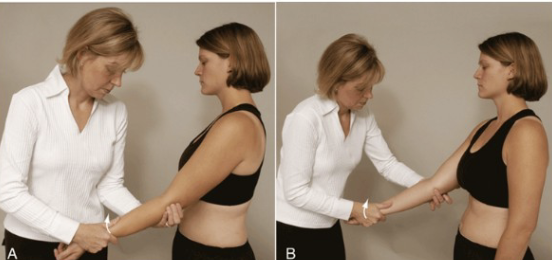
Mill’s
Tests for:
• Inflammation at the lateral epicondyle
• Commonly called tennis elbow
•Positive sign:
• Severe pain @ lateral epicondyle
•Method 2: (AKA- Mill’s)
• Therapist palpates the lateral
epicondyle , then passively
pronates, flexes wrist, and extends elbow
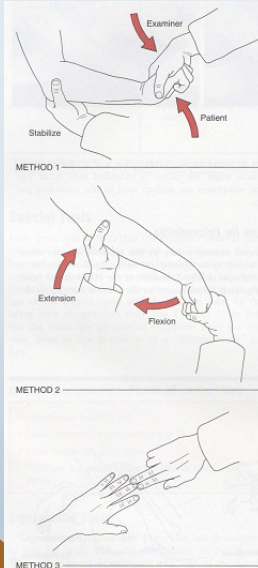
Reverse Mill’s
Tests For:
epicondyle of the humerus
• Commonly called Golfer’s elbow
•Positive sign:
• Severe pain medial epicondyle
• Reverse Mill’s
• Therapist palpates the medial
epicondyle
• Patients forearm is passively
supinated while the elbow and wrist extend
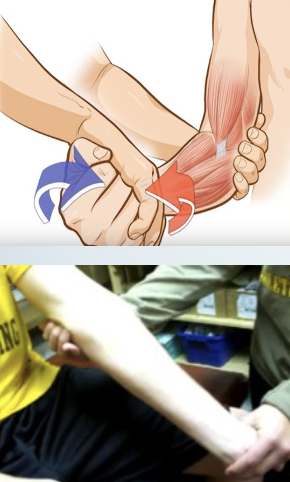
Cozen
Tests for:
• Inflammation at the lateral epicondyle
• Commonly called tennis elbow
•Positive sign:
• Severe pain @ lateral epicondyle
•Method 1: (AKA- Cozen’s)
• Patients elbow stabilized by
therapists thumb resting on lateral
epicondyle
• Patient makes fist, pronates,
radially deviates, and extends the
wrist with the therapist resisting
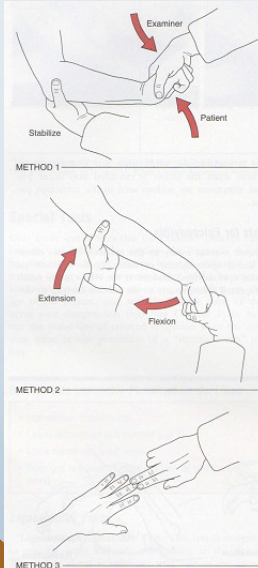
Reverse Cozen’s
• Inflammation of the medial
Tests For:
epicondyle of the humerus
• Commonly called Golfer’s elbow
•Positive sign:
• Severe pain medial epicondyle
•Method:
• Reverse Cozen’s
• Patients elbow stabilized by
therapists thumb resting on medial
epicondyle
• Patient makes fist, supinates, ulnar
deviates, and flexes wrist with the
therapist resisting
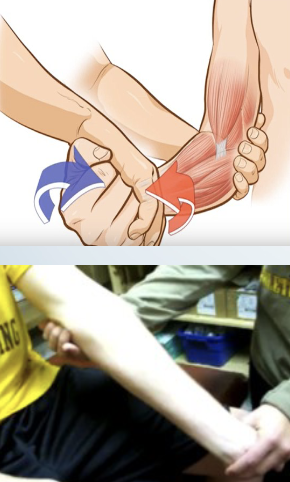
Tinels: Elbow
•Tests for:
• Ulnar nerve compression/
regeneration status
•Positive sign: • Tingling sensation in
ulnar distribution (the distribution of these
symptoms informs you how far the nerve has
regenerated/or the level of damage)
•Method:
• Tap the groove between
the olecranon and medial
epicondyle
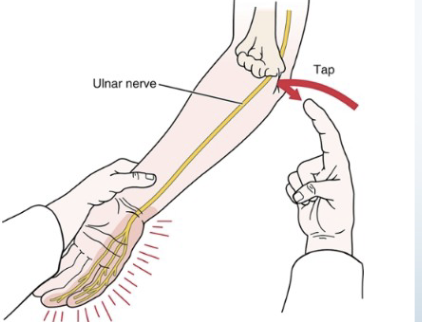
Wrist Tests
Radial Ligamentous
• Tests for: Ulnar collateral ligament
• Positive sign: • Pain and hypermobility
• Method:
• Place client in supination one
hand stabilizes proximal to
wrist
• Passively move hand into
radial deviation with over pressure
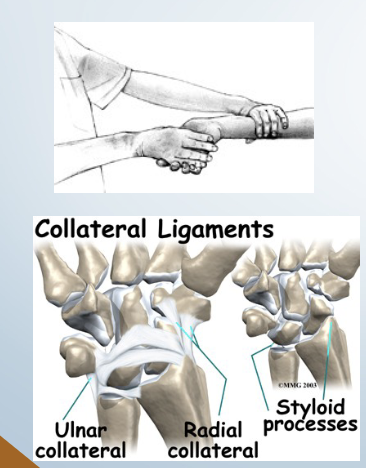
Ulnar Ligamentous Stress Test
• Tests for:• Radial collateral ligament
• Positive sign: • Pain and hypermobility
• Method:
• Place client in supination one
hand stabilizes proximal to
wrist
• Passively move hand into ulnar
deviation with overpressure

Finklestein’s Test
•Tests for:
• DeQuervain’s
disease/tenosynovitis/paratenonitis
(APL/EPB)
•Positive sign:
• Pain over the abductor pollicis longus and
extensor pollicis brevis tendon at the
wrist
• Most people have some degree of
discomfort with this test, comparing
bilaterally confirms
•Method:
• Patient makes a fist with the thumb
inside the fingers
• Examiner stabilizes forearm and deviates
wrist toward ulnar side
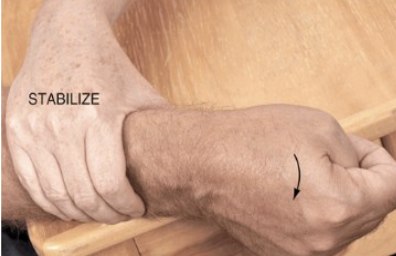
Phalen’s Test
•Tests for: Carpal tunnel syndrome
•Positive sign:
• Tingling sensation in the
thumb index finger and
middle and lateral half
of ring finger (median
nerve distribution)
•Method:
• Examiner flexes patients
wrists maximally and
holds this position for 1 min pushing the wrists
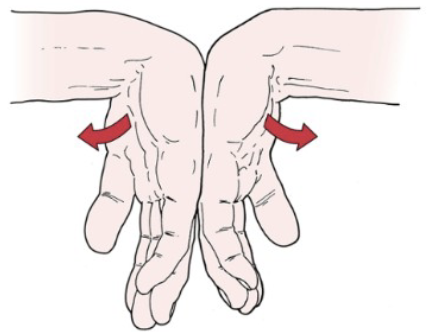
Reverse Phalen’s Test
•Tests for: Median nerve
pathology
•Positive sign: Same as Phalen’s- Tingling sensation…
•Tingling sensation in the
thumb index finger and middle and lateral half
of ring finger (median nerve distribution)
•Method:
• Therapist places patients wrists in full extension and then
draws downward
• Apply overpressure forst
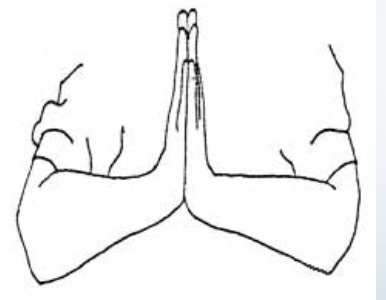
Leg Tests
Craig’s Test
Tests for: Femoral head anteversion or retroversion
Positive sign: Excessive anteversion (>15°) leading to squinting patella or retroversion (<5°)
Method:
Patient lies prone with knee flexed to 90°
Therapist palpates posterior aspect of greater trochanter
Passively rotate the hip medially and laterally until parallel with the table
Estimate the degree of anteversion based on lower leg angle
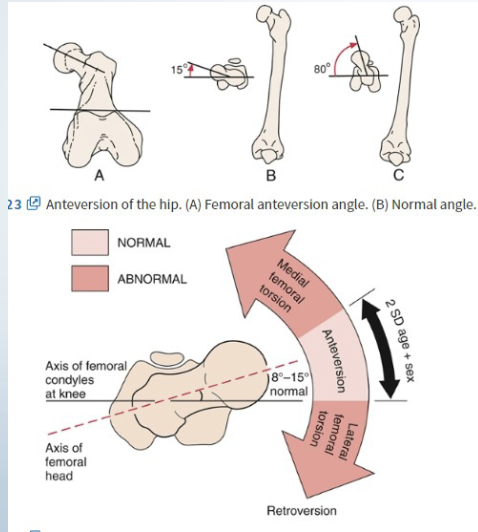
Gaenslen’s Test
Tests for: Ipsilateral SI joint lesion, hip pathology, L4 nerve root lesion
Positive sign: Pain
Method:
Patient lies sidelying on the unaffected side
Flex the hip and knee closest to the table
Therapist passively extends the hip while stabilizing the pelvis

SI Gapping
•Tests for: •Sprain in anterior sacroiliac joints
•Positive sign:
•Unilateral glut pain or posterior leg pain
•Method:
•Patient supine while examiner applies cross-arm pressure to ASIS
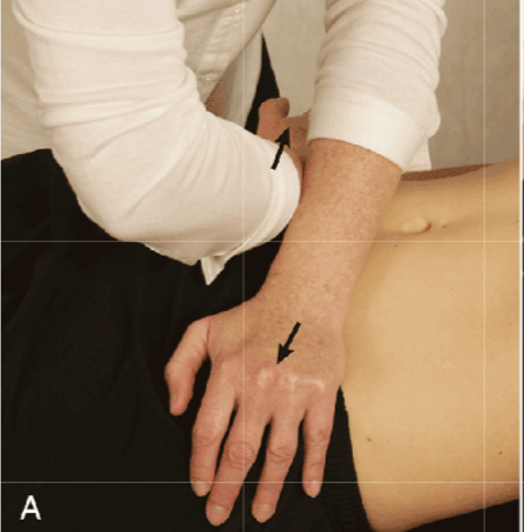
Squish Test
Tests for: Sprain in posterior sacroiliac joints
Positive sign: SI pain
Method: Patient supine while examiner applies medial and inferior pressure to ASIS
can be done in sideline
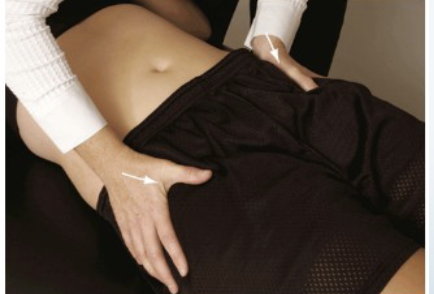
Faber’s/ Patricks Test
•Tests for:
• Hip joint pathology
• Iliopsoas pathology
•Positive sign: Test side knee remains
above opposite knee, pain
•Method:
• Client is supine
• Therapist places patients leg so that the foot of the test leg is on top of the knee of
the opposite leg
• Allow knee to drop laterally
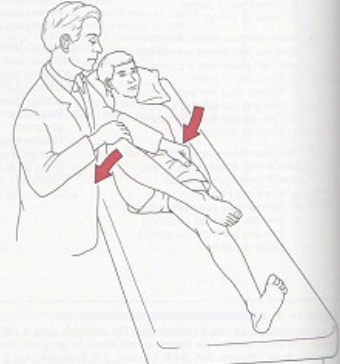
Apparent/ True Leg Length Test
How the test is performed
• Client lies supine
• A measurement between ASIS and one of the maleoli (usually medial)
• Measure both legs
• Positive sign: A difference of more than 1.5 cm
• Tests for
• Slight difference but within the normal range: leg length usually stems from the position of the innominate
• If beyond normal indicates unequal bone length
NOTE: Apparent leg length is umbilicus to medial malleoli and is often a positional
issue
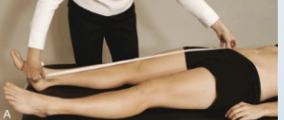
Ely’s Test
Tests for: Contracture of rectus femoris
Positive sign: Pelvis raises off the table on same side, Pain in anterior thigh
Method: Patient lies prone, therapist flexes knee, observe movement of pelvis
NOTE: This is sometimes called the
Prone Knee Bending or Nachlas test
• Additional +ves:
• Pain in lumbar= L3 nerve root, lumbar
joint compression
• Pain at SI= hypomobile SI joint
Muscle length: Ely’s Test

90/90 Test
Tests for: Contractured hamstrings
Positive sign: Extended knee within 20° of full extension
Method: Patient is supine with knees flexed, actively extend one knee at a time
Straight Leg Raise Test
Tests for:
Disc herniation
Dura matter impingement/irritation
Sciatic root impingement
Lumbar facet irritation
SI pathology
Hamstring length
Positive sign:
With neck and dorsiflexion most likely dura matter irritation or a lesion within the spinal cord (disc herniation, tumor etc.)
Back/hip pain with hip flexion below 70 degrees indicates SI pathology
Pain with hip flexion over 70 degrees indicates lumbar vertebral joint (facet) involvement
Back and leg pain with hip flexion up to 70 degrees indicates sciatic nerve root irritation (L5, S1, 52)
Method:
Patient in supine position with hip medially rotated and adducted, knee extended
Therapist flexes hip until pain occurs
Therapist reduces hip flexion until comfortable for patient and then asks patient to flex neck while therapist dorsiflexes foot (This step is sometimes called Lasegue's
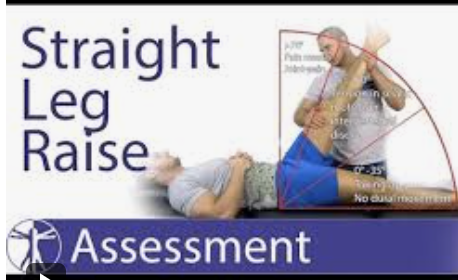
Ober’s Test
•Tests for: TFL/ITB contracture
•Positive sign:
• Leg does not lower to table
• Leg flexed likely TFL
• Leg extended likely ITB
• Pain can indicate trochanteric bursitis
•Method:
• Patient lays sidelying with lower leg flexed at hip and knee for stability
• Therapist abducts and extends the patients upper leg with knee straight or flexed to 90 degrees
• Therapist then lowers the limb
• Therapist should stabilize clients pelvis so they don’t feel like they are falling backward
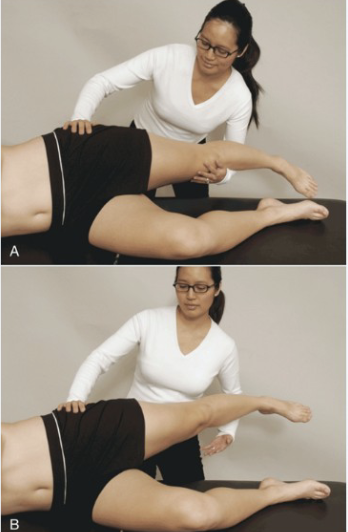
Piriformis Length Test
Tests for: Piriformis contracture, Piriformis Syndrome
Positive sign:
Pain in the piriformis muscle (stretch) or
neurological pain in a sciatic distribution
Method:
Client in sidelying (test leg on top) , knee and hip flexed (60º),
Stabilize pelvis and apply downward pressure to test leg
Kind of feel like they are going to all off of the table
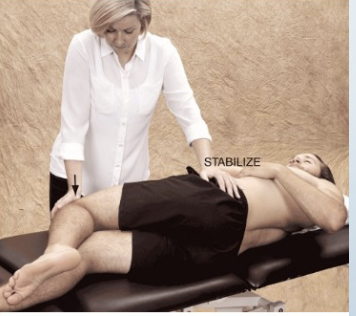
Trendelenburg’s Test
Test’s For:
• Weak gluteus medius
Muscle Strength: Trendelenburg’s
Positive sign:
• Client is observed for the pelvis dropping on the
non-weight bearing side
Method:
• Client is standing
• Therapist asks the client to stand on one leg
• Can increase difficulty by adding a squat motionS
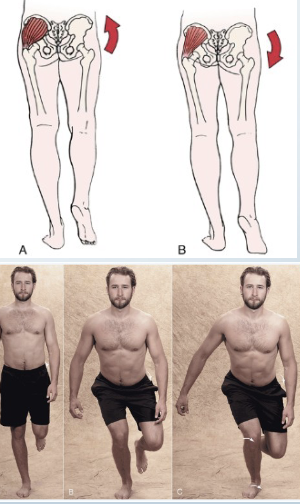
Thomas Test
Tests for: Hip flexor contracture
Positive sign: Opposing leg remains slightly flexed, excessive lordosis
Cannot fully extend leg, gap under knee
Method: Patient supine, one leg slowly extends while other remains flexed to chest
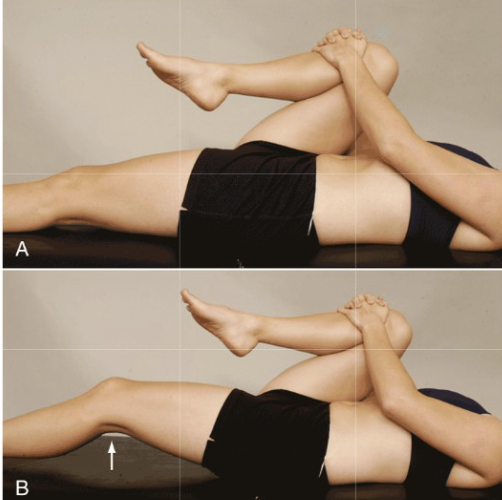
Knee SOTs
Varus Stress Test
•Tests for: Lateral instability/ lateral collateral ligament
•Positive sign: Hypermobility
•Method:
• Patient is supine
• Therapist places a varus stress on the knee
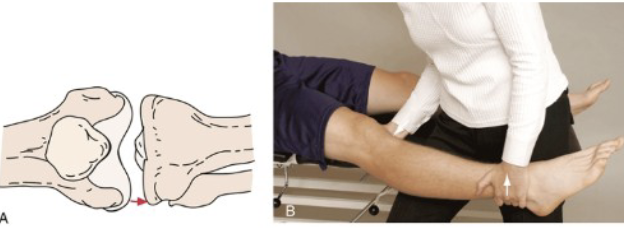
Valgus Stress Test
•Tests for: Medial instability/medial collateral ligament
•Positive sign: Hypermobility
•Method:
• Patient is supine
• Therapist places a valgus stress on the knee
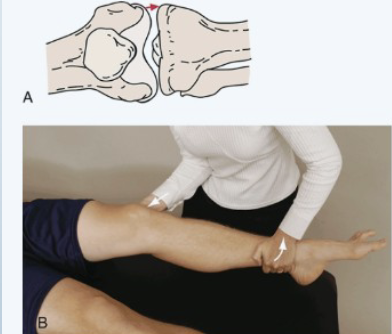
Anterior Drawer of the Knee
Tests for: Anterior cruciate ligament instability
Positive sign: More than 6mm anterior translation
Method: Patient knee flexed to 90°, therapist stabilizes foot (Sit on it with towel underneath) and draws tibia forward on the femur
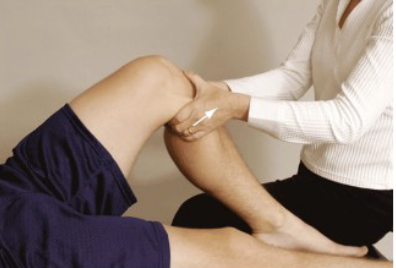
Posterior Drawer of the Knee
Tests for: PCL instability (Posterior Cruciate ligament)
Positive sign: Hypermobility and pain
Method: Patient knee flexed to 90° and hip flexed to 45°
• First observe for “Sag sign” a
sulcus inferior to the femur
• If not present therapist stabilizes
clients foot with body weight (sit on it with towel underneath)
• Therapist then pushes the tibia backward on the femur
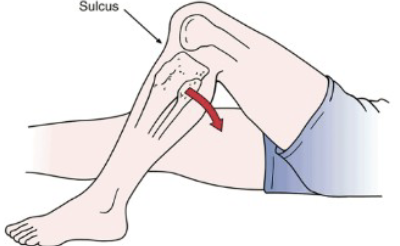
Lachman’s Test
Tests for: ACL injury (anterior cruciate Ligament)
Positive sign: Soft/mushy end feel/ hypermobility
Method: Patient supine with knee at 30° Flexion, therapist pulls tibia anteriorly and pushes femur posteriorly
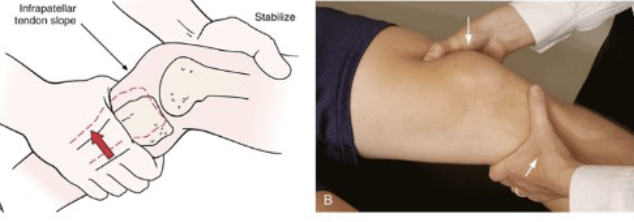
Noble’s Compression Test
Tests For: ITB friction syndrome = inflammation of the ITB as it rubs
Positive sign: Pain at approximately 30º of flexion
Method:
• Client lies supine with hip and knee
flexed
• Therapist places pressure on the lateral
femoral epicondyle over the ITB
• Client extends
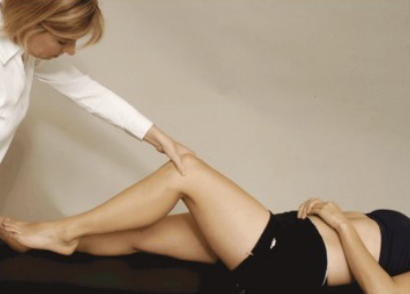
Slocum’s Test Part 1
• Tests for:
• Anterolateral rotary instability
• Some degree of injury to the following:
• ACL/PCL/LCL/ITB
• Posterolateral capsule
• Arcuate-popliteus complex
• Positive sign: Pain in the lateral knee, Excessive movement
• Method:
• This is anterior drawer with a twist
• Client supine
• Knee flexed to 90º, hip flexed to 45º, knee
medially rotated to 30º
• Therapist sits on client’s foot for stability
• Tibia is drawn forward
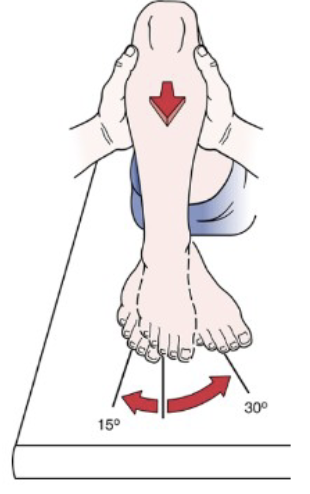
Slocum’s Part 2
Tests For: Anteromedial instability
Method:
• Externally rotate to 15 degrees and pull anteriorly
again
Tests for:
• MCL/ACL, posteromedial capsule, posterior oblique
Hughston’s Test
Tests for
• Posterolateral/posteromedial rotary instability
• Some degree of injury to the following:
• Postlat=PCL/MCL
• Postmed=PCL/LCL
Positive sign: Excessive movement of tibia
Method:
• This is posterior drawer with a twist
• Client supine/seated knee flexed to 90º
• Medial/lateral rotationn of
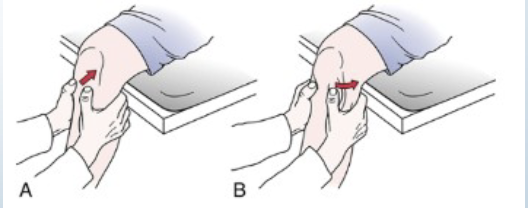
Lateral Pivot Test
•Tests for: Anterolateral rotary instability, ACL rupture, ITB injury
•Positive sign: Client reports a “giving away”
•Method:
•Client in supine
•Hip flexed and abducted 30º slight medial rotation 20º
•Therapist holds foot with one hand, knee with other (hand placed posterior to the head of the fibula)
•Knee is extended
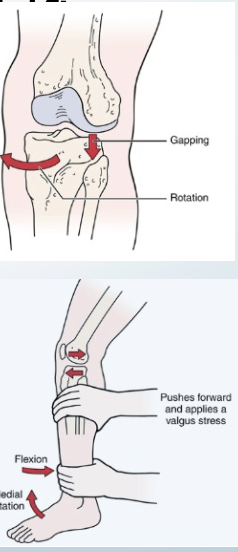
Apley’s Compression and Distraction
Tests for: Meniscus injury/ligament injury
•Positive sign:
• If rotation with distraction is more painful or
hypermobile indicates a ligamentous injury
• If rotation with compression is more painful then
meniscus
•Method:
• Client prone with knee flexed to 90 degrees
• Therapist stabilizes clients thigh with their knee
• Therapist then medially and laterally rotates the tibia combined
with distraction
• Repeat process with compression
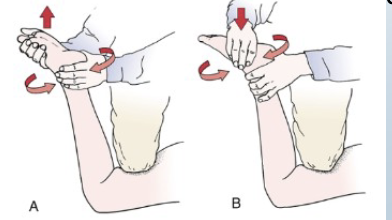
Bounce Home Test
Tests for: Meniscus injury/foreign body
•Positive sign: If the knee doesn’t reach full extension/ rubbery end feel/pain
•Method:
• Client lies in supine with heel cupped in therapists hand
• Clients knee is fully flexed and then allowed to passively come
into extension
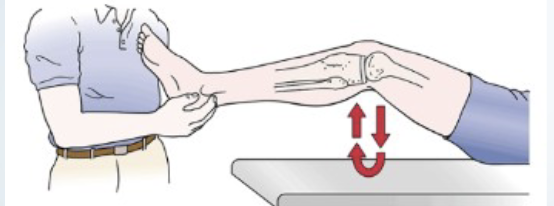
McMurray’s Test
•Tests for: Meniscal injury
•Positive sign: Clicking/popping/snapping
• With medial rotation=lateral meniscus
• With lateral rotation= medial meniscus
•Method:
• Patient lies supine with the knee completely flexed
• Therapist then medially rotates the tibia and extends the knee
• Repeat with knee laterally rotated
This one you be kind of rough with the knee
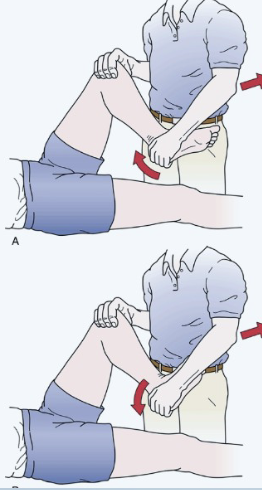
Helfet’s Test
• Tests for:
• Meniscus tear, impaired
quadriceps function leading to
lack of “screw home” mechanism
• Positive sign:
• Tib tub not aligning with midline
of patella @ 90 degrees flexion
• Tib tub not aligning with lateral
border of patella in extension
Method:
client sits with legs of edge of table
feel tibial tuberosity when leg is bent
The feel its position when leg is straight
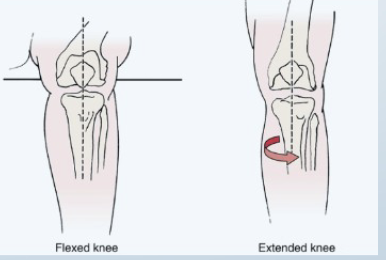
Brush Effusion
•Tests for: Minimal effusion
•Positive sign: Wave of fluid passes to the medial side of the joint and bulges
just below medial distal portion of the patella (pes anserine)
•Method:
• Client is supine
• Therapist commences just below joint line on medial side of the patella
and strokes proximal toward patients hip up to the suprapatellar
pouch, two or three time
• With opposite hand therapist strokes down lateral side of patella
Very light stroking movements
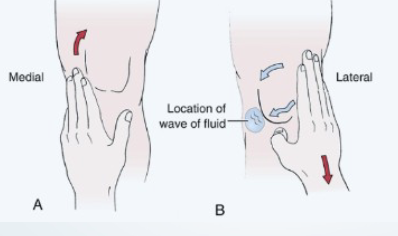
Clarks Patellofemoral- patella grind test
•Tests for: Patellofemoral dysfunction
•Positive sign: Pain
•Method:
Client is supine
• Therapist presses down with the
web space of their hand on the
superior patella while asking the
client to contract their quadriceps
• Can be repeated at 30, 60 and 90
degrees of flexion to test the
different contact surfaces of the
patella
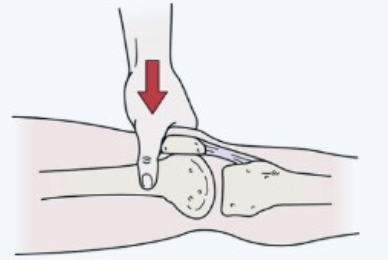
McConnell’s Test
•Tests for: Patellofemoral dysfunction/chondromalacia
•Positive sign: Pain disappears with medial patella accommodation
•Method:
•Client is seated with femur laterally rotated
•Patient performs isometric quadriceps contractions at 120, 90, 60, 30, 0 and holds each for 10 seconds
•If pain is produced at any level the leg is returned to full extension and the therapist then pushes the patella medially
•The client then tries the contraction from the previously painful range again

Waldron’s Test
Tests for:
• Patellofemoral dysfunction
Positive sign:
• Pain, crepitus, tracking dysfunction
Method:
• Client performs AFROM or squat with therapist palpating patella
Ankle SOTs
Anterior Drawer of the Ankle
•Tests for:
• Anterior talofibular ligament
instability
•Positive sign:
• Excessive anterior movement
• Depression of the skin on both sides
of the achilles
•Method:
• Patient lies prone, or supine with feet
extending over end of table
• Therapist pushes the heel forward, or
pulls foot forward while pushing tibia
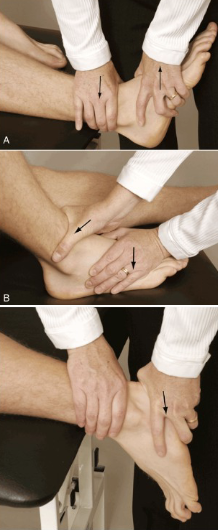
External Rotation Test/ Kleiger’s
Tests for: Deltoid ligament sprain or syndesmosis tear
Positive sign: Pain medial and lateral, potential talus displacement from medial malleolus
Method: Client seated, Knee flexed foot relaxed
Therapist rotates foot laterally
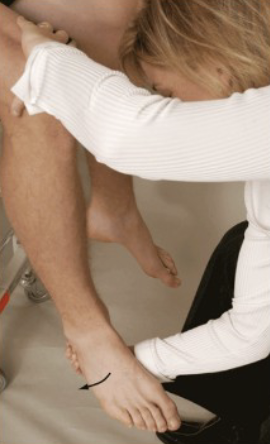
Talar Tilt
•Tests for: Calcaneofibular ligament tear, deltoid ligament
•Positive sign:
• Excessive movement with adduction= calcaneofibular ligament
(some anterior talofibular ligament)
• Excessive movement with abduction= deltoid ligament
(tibionavicular, tibiocalcaneal, posterior tibiotalar ligaments)
•Method:
• Client is prone, supine or sidelying with knee slightly flexed to
relax the gastrocnemius
• Therapist holds foot in 90 degree position
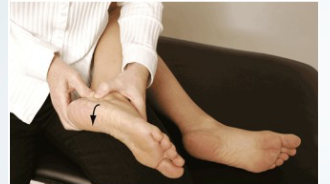
Homan’s Test
•Tests for: DVT (deep vein thrombosis)
•Positive sign: Pain in calf
• Can be accompanied by pallor,
swelling, loss of dorsalis pedis pulse
•Method:
• Therapist passively dorsiflexes patients foot
with the knee extended
• Pain also on palpationc
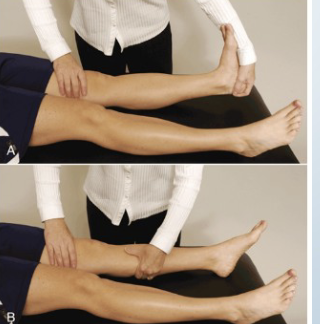
Morton’s Test
•Tests for: Morton’s neuroma, stress fracture
•Positive sign: Pain
•Method:
• Patient lies supine
• Therapist grasps foot at metatarsal heads and squeezes them together
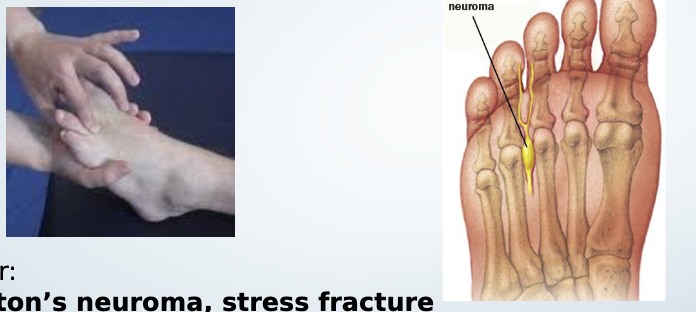
Spine SOTs
Spurlings Test
Tests For: Identifies nerve root compression.
Positive Sign: Pain radiating into the arm on the affected side, increased neurological symptoms.
Identify the affected dermatome/ nerve root involved through pain pattern
Method:
Patient sidebends cervical spine towards the unaffected side first.
Therapist applies straight downward pressure on the head.
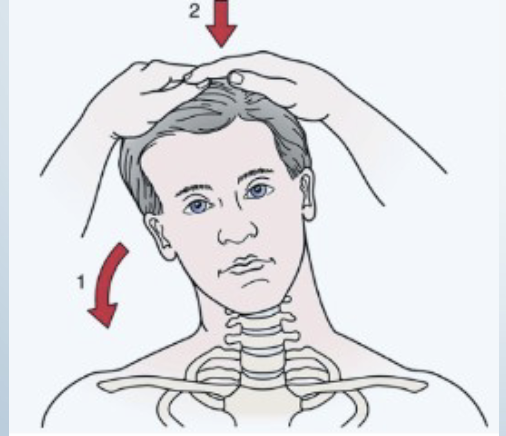
Cervical Distraction Test
Purpose: Tests for nerve root compression.
Positive Sign: Decreased pain when traction is applied.
Method:
Therapist places one hand under the patient's chin and the other cradling the occiput.
Slowly lift the patient's head to traction the cervical spine.
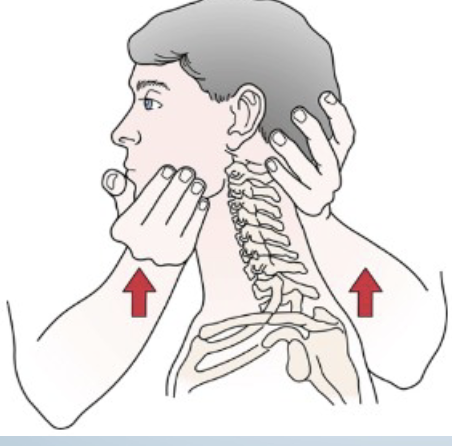
Scalene Cramp Test
Tests For: Identifies scalene trigger points.
Positive Sign: Increased pain due to scalene trigger points of the side rotated toward.
Method:
Patient rotates head towards the affected side and pulls chin towards the clavicle.
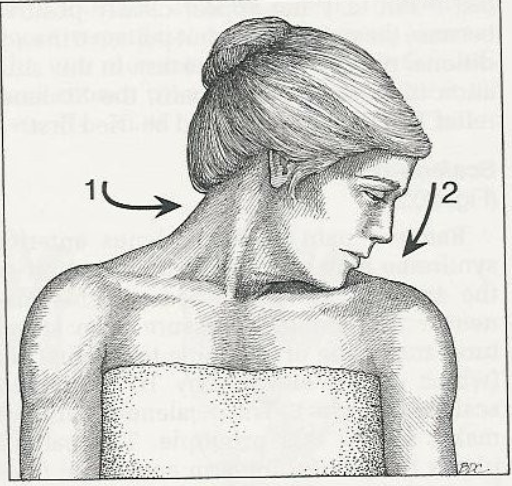
Vertebral Artery Test
Tests For:
The Vertebral Artery Test assesses the integrity of the vertebral arteries and checks for potential vascular insufficiency related to cervical spine movement.
Method:
The patient is positioned supine. The examiner rotates the patient's head to one side while observing for signs of vascular insufficiency.
Positive Sign:
Dizziness, tinnitus, visual disturbances, or other neurological symptoms indicate a positive test, suggesting potential vertebrobasilar insufficiency, eyes wavering
Hautant Test
Tests for : Differentiates between dizziness caused by articular problems and vascular problems.
Positive Sign:
step 1: arms move= nonvascular dizziness
step 2: Arms move = vascular impairment
Method:
Step 1: Patient flexes arms to 90 degrees, closes eyes for 10-30 seconds.
Watch for Loss of arm position = potential vascular issue.
Step 2: Patient rotates and extends neck (arms out eyes closed) while observing for loss of arm position.
hold 30 seconds
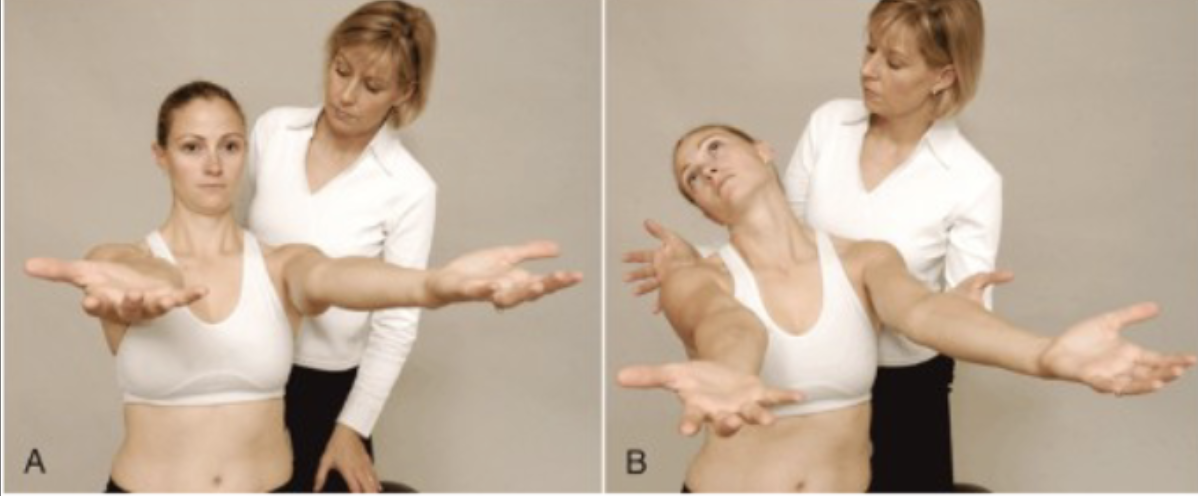
Adam’s Forward Bend
Tests for: scoliosis
Positive sign: Assymetry (one side is higher than the other)
Method:
patient needs to bend forward, starting at the waist until the back comes in the horizontal plane, with feet together, arms hanging, amd the knees in extension. The palms are held together
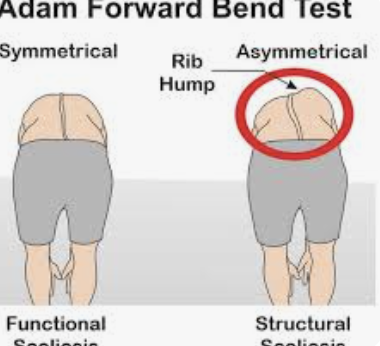
Valsalva
Tests for: Tests for space-occupying lesions (herniated disc, tumors).
Positive Sign: Increased pain indicating pressure on the spinal cord.
Method: Patient takes deep breath, holds it, then pushes down as if blowing up a balloon.

Kemp’s Quadrant
Purpose: Evaluates facet joint and nerve root compression.
Positive Sign: Local pain on facet side, recreation of neuro symptoms indicate nerve root involvement.
Method: Client stands, puts hand on posterolateral thigh
therapist directs them to extend, sidebend, and rotate (slide hand down towards knee) while therapist applies overpressure.
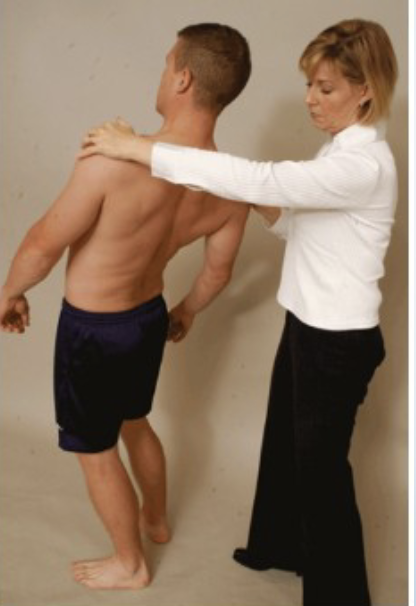
Kernig’s Test
Tests for: meningitis, Kernig's test is a physical examination maneuver used to assess for meningeal irritation, often indicative of meningitis.
Positive sign: Pain in the neck,
Resistance or pain when attempting to straighten the knee indicates a positive Kernig's test, suggesting meningeal irritation.
Method: client lies supine,
The patient lies on their back, and the examiner flexes one knee and hip to 90 degrees. The knee is then straightened.
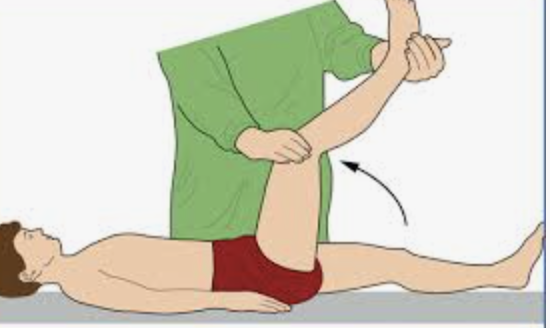
Slump Test
Purpose: Tests for impingement of dura, spinal cord, or nerve roots.
Positive Sign: Neurological symptoms such as sciatica or electric nerve pain anywhere.
Method: Ask client slumps forward (leave head elevated), chin to chest, therapist applies overpressure.
If symptoms do not occur, Extend one knee and dorsiflex foot to provoke symptoms.
(SOTO- HALL- same thing but supine)
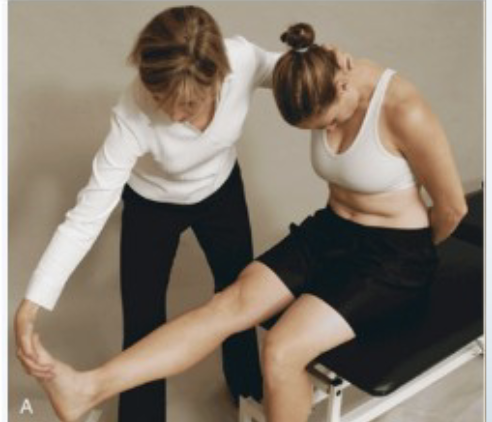
Rebound Tenderness Test
Tests for: appendix
Positive: Pain continues when pressure released
Method: Client supine, push right above iliac crest with some pressure then releasee
SLR- straight leg raise
Tests for:
Disc herniation
Dura matter impingement/irritation
Sciatic root impingement
Lumbar facet irritation
SI pathology
Hamstring length
Positive sign:
With neck and dorsiflexion most likely dura matter irritation or a lesion within the spinal cord (disc herniation, tumor etc.)
Back/hip pain with hip flexion below 70 degrees indicates SI pathology
Pain with hip flexion over 70 degrees indicates lumbar vertebral joint (facet) involvement
Back and leg pain with hip flexion up to 70 degrees indicates sciatic nerve root irritation (L5, S1, 52)
Method:
Patient in supine position with hip medially rotated and adducted, knee extended
Therapist flexes hip until pain occurs
Therapist reduces hip flexion until comfortable for patient and then asks patient to flex neck while therapist dorsiflexes foot (This step is sometimes called Lasegue's
Tinels at the wrist
•Tests for: •Carpal tunnel syndrome
•Positive sign:
•Tingling sensation and paraesthesia into thumb index finger and middle and lateral half of ring finger (median nerve distribution)
•Must be felt distal to the tapping
•Indicates rate of regeneration of median nerve
•Method: •Tap the carpal tunnel at the wrist
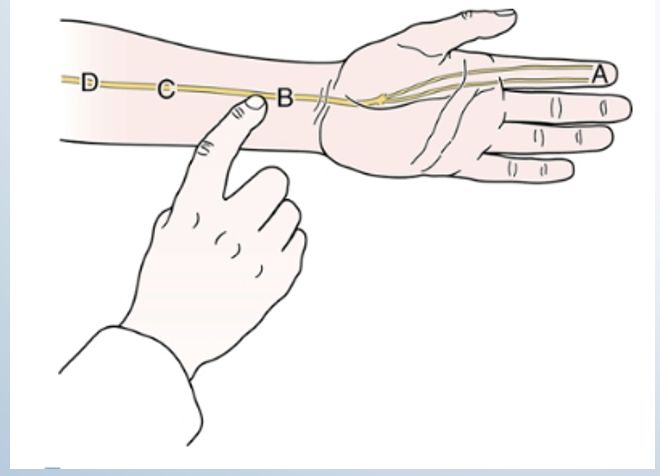
Allens test
•Tests for: Circulation of the Ulnar and radial artery
•Positive sign:
•Unequal or slow (6 seconds) flushing in the hand when the blood flow is allowed to return
•Method:
•Patient is asked to open and close the hand several times quickly
•Then patient squeezes hand tightly
•Therapist places thumb and index finger over radial and ulnar arteries compressing them
•Patient opens hand while therapist maintains pressure
•Then remove pressure from one artery and watch for flushing
•Repeat for other artery
